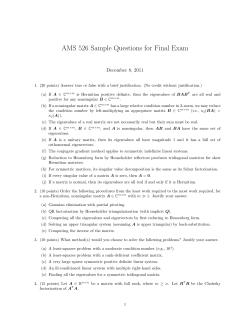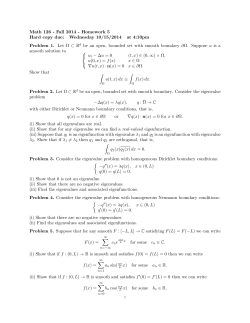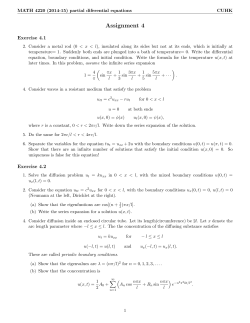
AMS 210 (Section 02) (Applied Linear Algebra) Final (Sample Questions)
AMS 210 (Section 02) (Applied Linear Algebra) Final (Sample Questions) Time: 150 min Name:_____________________________________ SB ID: _____________________________________ Calculator Model:____________________________ (Calculators must be Non-Programmable) Instructions: 1. 2. 3. 4. 5. You may choose to solve any problems and parts which make your total attempt worth 100 points. Maximum number of points you may score on this test is 100. Circle the problems and parts you want us to grade on this sheet itself. (For example, if you decide to solve (and us to grade) Problem 2, part b, you should circle Problem 2 and Part b) If the circled problems and parts are worth MORE than 100 points, your grade will be SCALED to 100. (For example, if circled problems and parts are worth 120 points and your score is 115, then final score will be 95.83/100.) If the circled problems and parts are worth LESS than 100, NO SCALING will be done. (For example, if circled problems and parts are worth 95 points and your score is 95, then final score will be 95/100.) Non-Programmable Calculators are allowed. Write the model number above. Sample Questions on Rabbit-Fox Model: 1. Consider the rabbit fox model: 𝑅′ = 𝑅 + .1𝑅 − .2𝐹 𝐹 ′ = 𝐹 − .4𝐹 + .2𝑅 (a) (2 points) Write this model as 𝑝′ = 𝐴𝑝, where 𝑝′ = 𝑅′ 𝑎𝑛𝑑 𝑝 = 𝑅 . 𝐹 𝐹′ 2 1 (b) (3 points) Verify that 𝑎𝑛𝑑 are the eigenvectors of A and find corresponding eigenvalues. 1 2 (c) (10 points) If the initial population is R = 40 and F = 35, what is the stable population? Sample Questions on Optimization: 1. (10 points) Solve the following optimization problem graphically: Maximize: 8x + 12y Subject to: 3x + 5y ≤ 15, 3x + y ≥ 6, x ≥ 0, y ≥ 0. (Also consider variations of the problem above. E.g. Change in the feasible region due to change in the direction of inequalities, minimize the objective function instead of maximizing and so on.) Sample Questions on Eigenvalues, Eigenvectors and Eigenvalue Decomposition: 1. 2. 6 6 2 𝐴 = −5 −5 −2 5 6 3 (a) (10 points) Find eigenvalues and eigenvectors of A. (b) (10 points) Find eigenvalue decomposition. (c) (5 points) From the eigenvalue decomposition in part (b), what is the det(A)? (a) (5 points) Let λ1, λ2, … λn be the eigenvalues and u1, u2, … un be the corresponding eigenvectors of an n-by-n matrix A. What are the eigenvalues and corresponding eigenvectors of A k? Justify your answer. (b) (10 points) Show that a matrix A is invertible if and only if λ = 0 is not an eigenvalue. (c) (10 points) Let λ1, λ2 be two distinct eigenvalues of matrix A, and let u1, u2 be corresponding eigenvectors. Show that u1 and u2 are independent. (d) (5 points) Use part (c) to prove that the eigenvectors corresponding to distinct eigenvalues are independent. Sample Questions on Norms: 1. 𝐴= −4 2 −2 4 −7 3 5 −1 6 (a) (5 points) What are the sum and max norms of the 3-by-3 matrix A? (b) (5 points) If 𝑥 ′ = 𝐴𝑥, 𝑦 ′ = 𝐴𝑦 and 𝑥 − 𝑦 𝑚𝑥 = 2 , give a bound on 𝑥 ′ − 𝑦′ 𝑚𝑥 . (c) (5 points) If 𝑥 ′ = 𝐴𝑥, 𝑦 ′ = 𝐴𝑦 and 𝑥 − 𝑦 𝑠 = 4 , give a bound on 𝑥 ′ − 𝑦′ 𝑠 . (d) (5 points) Find a vector u such that 𝐴𝑢 𝑚𝑥 = 𝐴 𝑚𝑥 𝑢 𝑚𝑥 . (e) (5 points) Find a vector u such that 𝐴𝑢 𝑠 = 𝐴 𝑠 𝑢 𝑠 . (f) (5 points) Find a vector u such that 𝑢 𝑚𝑥 = 13 and 𝐴𝑢 𝑚𝑥 = 𝐴 𝑚𝑥 𝑢 𝑚𝑥 . (g) (5 points) Find a vector u such that 𝑢 𝑠 = 10 and 𝐴𝑢 𝑠 = 𝐴 𝑠 𝑢 𝑠 . 2 𝑒 2. (5 points) Show that 𝑎 ⋅ 𝑎 = 𝑎 , for any vector 𝑎 . 3. (5 points) Let D be a square matrix with all positive entries. Let 𝐷 < 1. Show that lim 𝑛 →∞ 𝐷𝑛 = 0. Sample Questions on the iterative scheme 𝒖(𝒌+𝟏) = 𝑫𝒖(𝒌) + 𝒄: 1. 2. 3. 15𝑥 +14𝑦 −13𝑧 = 30 5𝑥 −20𝑦 −17𝑧 = −40 −8𝑥 +5𝑦 +35𝑧 = 35 We wish to use the iterative scheme 𝑢(𝑘+1) = 𝐷𝑢 (𝑘) + 𝑐 to solve the above system. The requirement is that either 𝐷 𝑠 < 1 or 𝐷 𝑚𝑥 < 1 or both. What should be the matrix D? In which matrix norm is the required condition satisfied? (5 points) Make an initial guess 𝑢(0) and find 𝑢(1) 𝑎𝑛𝑑 𝑢 (2) . (10 points) Let 𝑢∗ be the exact solution of the system above. Show that 𝑢(𝑘+1) − 𝑢∗ 𝑠 < 𝑢 (𝑘) − 𝑢 ∗ 𝑠 . (15 points) Sample Questions on LU Decomposition: 1. (a) (10 points) Perform LU decomposition on the following matrix: 1 −3 −1 𝐴 = −2 4 4 2 −4 −2 (b) (5 points) From the LU decomposition above, what is det(A)? 2. 2 (5 points) Let 𝐴 = −4 2 1 0 𝐴 = 𝐿𝑈 = −2 1 1 3 2 1 −6 −1 . LU decomposition of A is given as follows: −4 4 0 2 2 1 0 0 −2 1 . 1 0 0 0 What do you conclude about the number of solutions to Ax = 0? Justify your answer. Sample Questions on Crammer’s Rule and Determinants: 1. (10 points) Solve the following system using Cramer’s Rule: 15𝑥 5𝑥 −8𝑥 2. +14𝑦 −20𝑦 +5𝑦 −13𝑧 −17𝑧 +35𝑧 = 30 = −40 = 35 (10 points) Find the determinant of the following matrix: 1 0 1 2 𝐴= −1 2 1 −2 0 3 3 3 1 4 4 4 Sample Questions on Inverse of Matrix: 1. (10 points) Find the inverse of A using Gauss-Jordan Elimination OR by Cofactor Method: 0 2 1 𝐴 = −1 −3 −1 3 4 1 Sample Questions on Regression and Pseudoinverse: 1. (a) (10 points) Consider the following set of data, which are believed to obey exponential law 𝑦 = 𝑟𝑒 𝑞𝑥 (approximately). x y 1 14 2 49 3 171 4 600 Perform a transformation y’=f(y) on y so that the regression model y’ = qx + r’ is fairly accurate. Determine q and r’, then reverse the transformation to determine r. (b) (10 points) Solve the same problem using pseudoinverse. 2. (5 points) We have studied two different linear regression models: (i) 𝑦 = 𝑞𝑥 and (ii) 𝑦 = 𝑞𝑥 + 𝑟 3 You are given a set of data which fit the curve 𝑦 = 𝑒1+𝑚 𝑥 approximately. Give a function 𝑦 = 𝑓(𝑦) which transforms the given relation into one of the linear regression models. 3. The following data indicate the number of accidents that bus drivers had in one year as a function of the number of years on the job. Years on Job Accidents 2 10 4 8 6 3 8 8 10 4 12 5 (a) (10 points) Fit these data with a regression model of the form 𝑦 = 𝑞𝑥, where x is number of years and y is the number of accidents. (b) (5 points) Solve part (a) using pseudoinverse. (c) (10 points) Fit these data with a regression model of the form 𝑦 = 𝑞𝑥 + 𝑟. (d) (10 points) Solve part (c) using pseudoinverse. Sample Questions on Balancing of Chemical Reactions: 1. (10 points) Balance the following chemical reaction. 𝑁2 𝐻4 + 𝑁2 𝑂4 ⟶ 𝑁2 + 𝐻2 𝑂 Sample Questions on Resistive Electric Circuits: 1. (10 points) Using Kirchhoff’s Voltage and Current Laws directly, find the current in each branch of the circuit. OR Using the method of loop currents, find the current in each branch of the circuit. (If you choose this method, you MUST USE THE LOOP CURRENTS SHOWN IN THE FOLLOWING CIRCUIT DIAGRAM.) Sample Questions on Linear Differential Equations with Constant Coefficients: 1. (a) (10 points) Using characteristic equation, solve the following differential equation: 𝑦 ′′ 𝑡 = 5𝑦 ′ 𝑡 − 4𝑦 𝑡 , 𝑦 0 = 20, 𝑦 ′ 0 = 5 (b) (5 points) Convert the equation in part (a) into a system of simultaneous first-order linear differential 𝑑𝑢 equations. (Write the given problem in the form = 𝐴𝑢 , and also write the initial conditions as a vector 𝑢0 . 𝑑𝑡 (c) (10 points) Using part b, solve the system by eigenvalues and eigenvector method. Sample Questions on Markov Chains: 1. If the stock market went up today, historical data show that it has a 60% chance of going up tomorrow, a 20% chance of staying the same, and a 20% chance of going down. If the market was unchanged today, it has a 40% chance of going up tomorrow, a 20% chance of staying the same, and a 40% chance of going down. If the market goes down today, it has a 20% chance of going up tomorrow, a 20% chance of being unchanged and a 60% chance of going down. (a) (5 points) Make a Markov chain for this problem; give the matrix of transition probabilities and transition diagram. (b) (5 points) If there is a 30% chance that the market goes up today, a 10% chance that it is unchanged, and a 60% chance that it goes down, what is the probability distribution for the market tomorrow? 2. We surveyed a group of students eating Vanilla, Strawberry and Chocolate ice cream about which flavor they would choose next time. The responses yielded the following transition matrix: Next Flavor Vanilla Strawberry Chocolate Vanilla 1/3 1/6 1/2 Current Flavor Strawberry Chocolate 1/4 1/10 5/8 1/5 1/8 7/10 (a) (5 points) How many rounds does it take on average for a person to have strawberry for the first time if he/she starts from chocolate? (b) (5 points) How many times on average does he/she have Vanilla along the way? (c) (5 points) If Tom starts from Chocolate and Merry starts from Vanilla, who is more likely to have tasted Strawberry before the other? 3. (a) (3 points) Give the definition of a regular Markov Chain. 𝑎 0 (b) (12 points) Let 𝐴 = , 0 < 𝑎 < 1. Show that this matrix cannot represent a regular Markov 1−𝑎 1 Chain. 𝑎𝑛 0 Hint: (i) Verify that the statement “𝐴𝑛 = ” is true when n = 1 and n = 2. 1 − 𝑎𝑛 1 (ii) Assume that the statement is true for some integer k, and write matrix 𝐴𝑘 . (iii) With explicit matrix multiplication, show that the statement is also true for k+1. (iv) From the previous three steps provide an argument (in one or two sentences) showing why should the statement be true for all integers n. (v) From the nature of the matrix An and the definition in part a, show that the Markov Chain is not regular. Sample Questions on Linear Transformations: 1. Give the matrices for each of the following linear transformations: (a) (5 points) Reflect any vector 𝑢 about the line y = -x, and then rotate it through 45o counterclockwise. (𝑢 is a 2D vector) (b) (5 points) Reflect any vector 𝑢 about the y-z plane and then project it onto x-z plane. (𝑢 is a 3D vector) (c) (5 points) Scale/Stretch a vector 𝑢 2 times along x-axis and ¼ times along y-axis (𝑢 is a 2D vector) 2. (a) (5 points) If we want to rotate a vector 𝑢 in x-y plane through an angle θ counterclockwise, what should be the corresponding rotation matrix? (b) (5 points) Show that in general, the eigenvalues of the rotation matrix are complex, and hence there are no real eigenvectors. (c) (5 points) How do you explain this result geometrically? Sample Questions on Graphs and Adjacency Matrix: 1. 1 0 0 𝐵= 0 1 1 0 1 0 1 0 1 0 0 1 1 1 0 0 1 1 0 0 1 1 0 1 0 1 0 1 1 0 1 0 0 (a) (5 points) Write the matrix B in partitioned form. (Give names to the submatrices you use.) (b) (5 points) Compute 𝐵2 in partitioned form; then write out all the entries in 𝐵2 . (c) (5 points) Draw the graph whose adjacency matrix is B. (d) (5 points) How many paths of length 2 are there between nodes 1 and 5? Write the sequence of nodes through which the paths pass. (e.g. a path of length 2 between nodes 1 and 2, which passes through node 6 may be written as 1 – 6 – 2). Sample Questions on Vector Space: 1. Determine whether the following sets are subspaces or not. Justify your answer. (a) (5 points) [x y] satisfying xy = 1. (b) (5 points) [x y] satisfying x = 2y and 2x = y. 2. 1 0 1 0 1 1 (10 points) Determine whether 𝑋1 = ,𝑋 = and 𝑋3 = are linearly dependent or independent in R4. 1 2 1 1 2 2 3 3. (a) (10 points) Find the bases for Range, Column space, Row space and Null space of the following matrix. 1 2 𝐴= 0 8 1 2 2 5 0 0 11 19 0 1 0 3 1 3 0 11 (b) (5 points) What is dim(col(A))? dim(null(A))? dim(row(A))? (c) (5 points) Express the dependent columns in A as a linear combination of independent columns. 4. 1 1 (5 points) 𝑎 = ,𝑏 = 1 1 perpendicular to 𝑎. 5. 1 1 2 0 1 𝐴= 2 2 5 0 3 0 0 0 1 3 1 2 . Decompose vector 𝑏 into two components, one parallel to 𝑎 and the other 3 4 (a) (10 points) Find an orthonormal basis for Col(A). (b) (10 points) Find an orthonormal basis for Null(A). 6. (10 points) Let 𝐴 = 1 1 . Perform QR decomposition. 1 2
© Copyright 2025





















